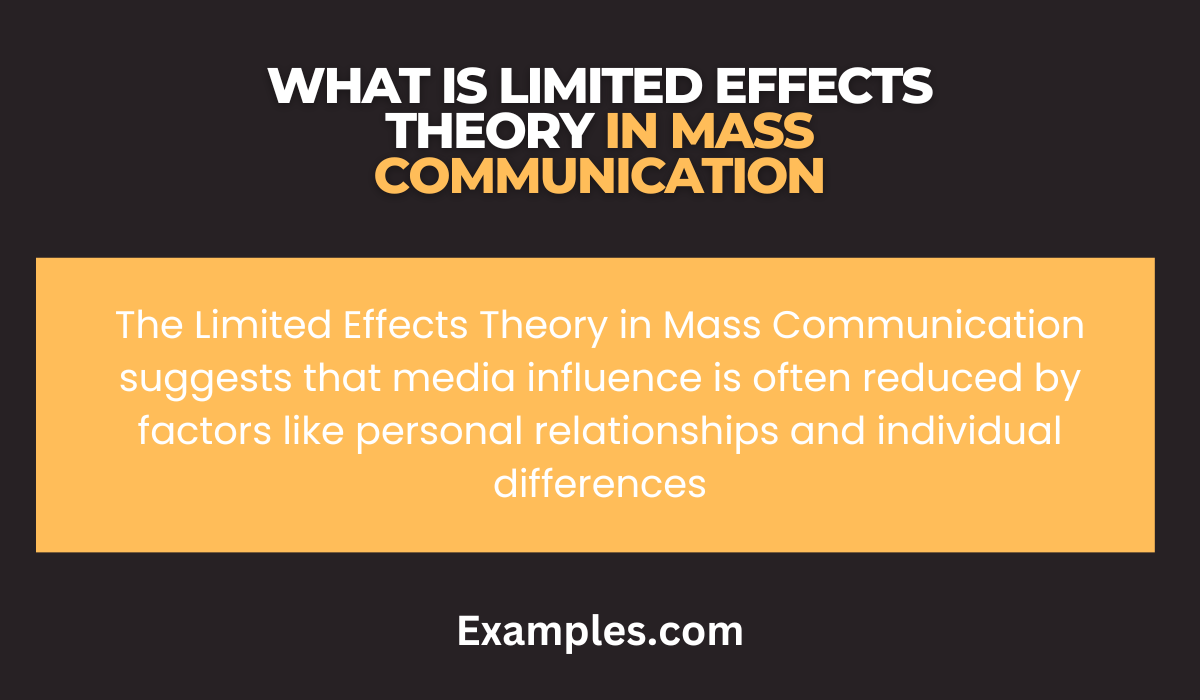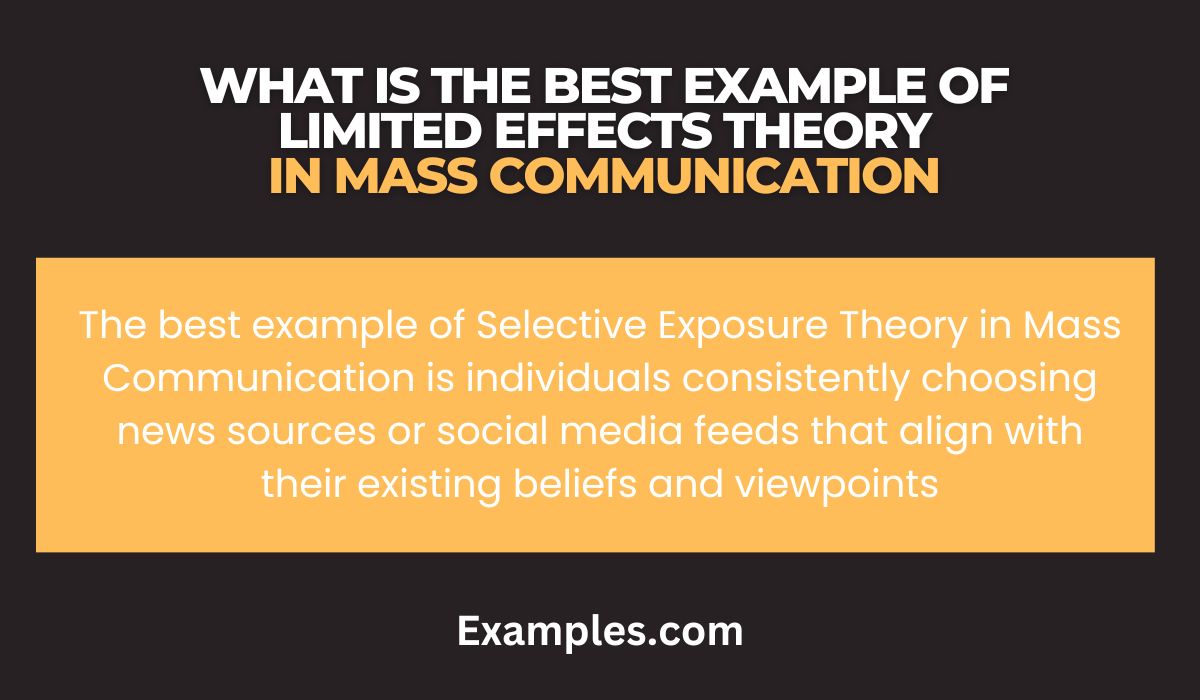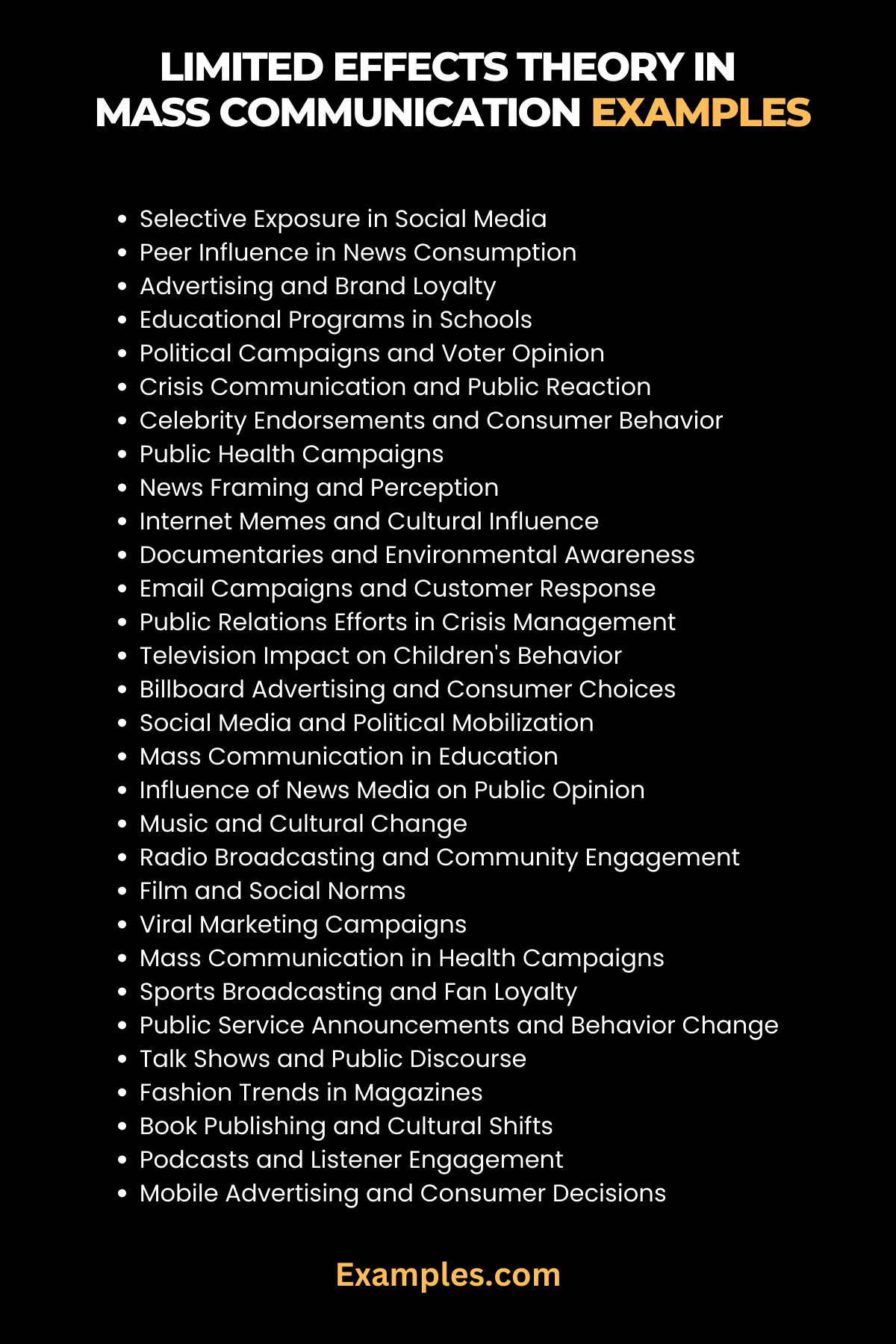29+ Limited Effects Theory in Mass Communication Examples
The Limited Effects Theory in Mass Communication serves as a fundamental concept in understanding how media influences audiences. Contrary to popular belief, this theory suggests that media’s impact on individuals is often less direct and powerful than assumed. Exploring this concept reveals crucial insights into the mass communication characteristics and the main functions of mass communication. As we delve into the intricacies of this theory, we uncover its relevance in various sectors, from journalism to public relations, reshaping our perception of media’s role in society.
What is Limited Effects Theory in Mass Communication
Limited Effects Theory in Mass Communication posits that media influence on individuals and society is not as powerful or direct as previously thought. This theory emerged as a response to the earlier Hypodermic Needle Theory, which suggested that mass media messages had a direct, immediate, and powerful impact on the public. The Limited Effects Theory, however, suggests that media’s influence is often mitigated by personal and social factors, leading to a more nuanced and less direct impact.

History of Limited Effects Theory in Mass Communication
The origin of the Limited Effects Theory can be traced back to the 1940s and 1950s, during which time several studies were conducted that challenged the idea of media’s omnipotent role in shaping public opinion. A seminal study in this field was Paul Lazarsfeld and his colleagues’ research on the 1940 Presidential election campaign in the United States. They found that personal influence and interpersonal networks played a more significant role in shaping voting behavior than the mass media. This finding led to the development of the Two-Step Flow Theory, which is often associated with the Limited Effects Theory.
What is the Best Example of Limited Effects Theory in Mass Communication
A classic example of the Limited Effects Theory in action can be observed in the context of public relations mass communication. For instance, in a crisis situation, a company’s public relations efforts through various media channels may not directly alter public perception. Instead, the effect of these communications is often filtered through individual biases, peer discussions, and pre-existing attitudes. This phenomenon demonstrates that despite extensive media efforts, the actual impact on public opinion is limited and mediated by other factors.
The Limited Effects Theory significantly changed the understanding of mass communication, leading to more sophisticated models that account for the complex interaction between media messages, individual psychology, and social dynamics. It remains a vital concept in understanding the role of media in society, particularly in the digital age where the flow of information is more diverse and multi-directional.

30 Examples of Limited Effects Theory in Mass Communication
The Limited Effects Theory in mass communication asserts that media’s influence on individuals is often less significant than previously assumed. Contrary to the Hypodermic Needle Theory, which suggests that media messages directly and uniformly affect the audience, the Limited Effects Theory posits that various personal and social factors mitigate the impact of mass media.
This theory emphasizes that individuals interpret and react to media content based on their pre-existing beliefs, social interactions, and selective exposure. It underscores the role of personal experience and peer groups in shaping one’s interpretation of media messages. This understanding is crucial in the domains of Journalism Mass Communication and Broadcasting Mass Communication, where the audience’s perception significantly influences the effectiveness of the communicated message.

- Selective Exposure in Social Media: People often choose content that aligns with their beliefs on social media platforms, demonstrating selective exposure. This behavior shows the limited effect of diverse media content on altering individual opinions significantly.
- Peer Influence in News Consumption: Friends and family can significantly influence how people interpret news stories. For instance, discussions among peer groups can shape an individual’s understanding of a political event, showcasing the limited direct effect of the news media.
- Advertising and Brand Loyalty: Consumers with strong brand loyalty are less likely to be swayed by competing advertisements. This resistance to change, despite exposure to persuasive advertising, illustrates the limited impact of mass communication in certain contexts.
- Educational Programs in Schools: The effectiveness of educational television programs in schools is often moderated by the teachers’ guidance and students’ prior knowledge. This scenario in Mass Communication Examples in School shows the limited direct impact of educational media on learning without the interplay of personal and contextual factors.
- Political Campaigns and Voter Opinion: During elections, political campaigns often have a limited effect on voters with strong party allegiances. This situation reflects the theory, as personal convictions and social networks play a more substantial role than media in shaping political views.
- Crisis Communication and Public Reaction: In crisis situations, the public’s reaction is not solely based on mass communication messages. Instead, individual experiences and community sentiments play a crucial role in influencing responses, indicating the limited effect of mass media.
- Celebrity Endorsements and Consumer Behavior: Celebrity endorsements in advertising have a limited effect on consumers who are skeptical of such promotions. This exemplifies the theory’s stance that media’s influence is not uniformly persuasive.
- Public Health Campaigns: Public health campaigns often see varied results due to individual health beliefs and social norms, showing that mass communication’s impact is not universally effective.
- News Framing and Perception: How news is framed can influence public opinion, but its effect is limited by individuals’ existing beliefs and knowledge. This example aligns with the theory by showing that media framing does not uniformly alter perceptions.
- Internet Memes and Cultural Influence: While internet memes can spread rapidly, their cultural impact is limited by the audience’s existing cultural understanding and sense of humor, again reflecting the theory’s principles.
- Documentaries and Environmental Awareness: Environmental documentaries may raise awareness, but changing individual behaviors often depends more on personal values and social circles, illustrating limited media effects.
- Email Campaigns and Customer Response: Email marketing campaigns might not significantly change customer behavior if they don’t align with the customers’ interests or needs, showcasing limited impact.
- Public Relations Efforts in Crisis Management: In crisis management, PR efforts can inform the public, but individual perceptions are heavily influenced by personal experiences and trust in the source, limiting the media’s effect.
- Television Impact on Children’s Behavior: While TV shows aim to influence children’s behavior, the actual impact is moderated by parental guidance and the child’s environment, reflecting the theory’s principles.
- Billboard Advertising and Consumer Choices: Despite widespread visibility, billboard advertising has a limited effect on consumers who are already loyal to a brand, demonstrating the theory’s relevance.
- Social Media and Political Mobilization: Social media campaigns can mobilize individuals for political causes, but their actual impact is often limited by the users’ pre-existing political leanings and offline networks.
- Mass Communication in Education: Educational mass communication tools have a varying impact on students, often influenced more by individual learning styles and classroom dynamics.
- Influence of News Media on Public Opinion: News media can shape public opinion, but its influence is limited by the audience’s pre-existing beliefs and the credibility they assign to the news source.
- Music and Cultural Change: Music as a form of mass communication can influence cultural trends, but its impact on individual attitudes and behaviors is limited by personal tastes and cultural backgrounds.
- Radio Broadcasting and Community Engagement: Radio programs aimed at community engagement may have varying success, influenced by the listeners’ existing community involvement and interests.
- Film and Social Norms: Films can reflect and challenge social norms, but their influence on changing these norms is limited by viewers’ pre-existing attitudes and societal context.
- Viral Marketing Campaigns: While viral marketing aims to broadly influence consumer behavior, its actual impact is often mitigated by individual preferences and skepticism towards marketing tactics.
- Mass Communication in Health Campaigns: Health campaigns via mass media can spread information, but changing health behaviors is often more influenced by personal health beliefs and doctor recommendations.
- Sports Broadcasting and Fan Loyalty: Sports broadcasts aim to engage fans, but their influence on changing team loyalty is limited, often entrenched in personal and community identity.
- Public Service Announcements and Behavior Change: PSAs can raise awareness on issues, but actual behavior change is frequently dependent on personal convictions and social influences.
- Talk Shows and Public Discourse: Talk shows contribute to public discourse, but their influence in changing opinions is limited by the viewers’ pre-existing beliefs and the influence of their social circles.
- Fashion Trends in Magazines: Fashion magazines showcase trends, but individual fashion choices are more influenced by personal style and social context, limiting the magazines’ direct impact.
- Book Publishing and Cultural Shifts: Books can introduce new ideas, but cultural shifts depend more on the societal reception and contextual factors beyond the books’ content.
- Podcasts and Listener Engagement: Podcasts can engage listeners on various topics, but the extent of influence is limited by the listener’s prior knowledge and interest in the subject.
- Mobile Advertising and Consumer Decisions: Mobile ads reach a wide audience, but their effect on consumer decisions is limited by personal preferences and ad relevance to the individual.
Role of Limited Effects Theory in Mass Communication
Limited Effects Theory plays a pivotal role in the realm of Mass Communication. This theory, initially developed in the mid-20th century, suggests that media impacts are often mitigated by a variety of factors, including personal relationships and pre-existing beliefs. Here are some key points highlighting its role:
- Mediator of Media Impact: It posits that media alone does not have a direct and powerful impact on audiences. Instead, it is mediated by individual differences, social categories, and personal relationships.
- Challenging the Hypodermic Needle Model: This theory counters the earlier Hypodermic Needle Theory of mass communication, which suggested that media messages directly influence and control the public.
- Influence on Public Relations and Advertising: In Public Relations Mass Communication and advertising, understanding this theory helps in creating more nuanced strategies that consider the indirect effects of media.
- Guidance for Content Creators: For those in Journalism Mass Communication and broadcasting, this theory underlines the importance of considering how audiences might interpret and contextualize media content.
Importance of Limited Effects Theory in Mass Communication
The importance of the Limited Effects Theory in mass communication is manifold, providing crucial insights for understanding media influence:
- Enhancing Audience Understanding: It aids in comprehending how audiences actively interpret and derive meaning from media, rather than being passive recipients.
- Informing Media Strategy: For careers in Mass Communication Jobs/Careers, this theory is essential for developing strategies that acknowledge the limited and indirect effects of media.
- Impact on Media Research: It has significantly influenced media research, encouraging the exploration of how personal and social factors interact with media effects.
- Relevance in Digital Age: In the context of Mass Communication Examples in a Digital Age, this theory is instrumental in analyzing how digital platforms with personalized content affect audiences differently.
How to Use Limited Effects Theory in Mass Communication
Implementing the Limited Effects Theory in mass communication involves several strategic approaches:
- Targeted Messaging: Recognizing that media effects are not uniform allows professionals in Mass Communication to tailor messages to specific audience segments.
- Focus on Social Context: This theory underscores the importance of understanding the social context and networks in which media is consumed.
- Incorporating Feedback Loops: In Social Media Mass Communication, using this theory means acknowledging the role of audience feedback and engagement in shaping media effects.
- Enhanced Audience Analysis: For Broadcasting Mass Communication, it involves analyzing how different audience groups might interpret and discuss media content within their social circles.
The Limited Effects Theory in Mass Communication posits that media’s impact is often mitigated by individual differences, social contexts, and interpersonal networks. It challenges notions of direct media influence, highlighting the complexity of how audiences interpret and respond to media messages within their personal and social environments.



